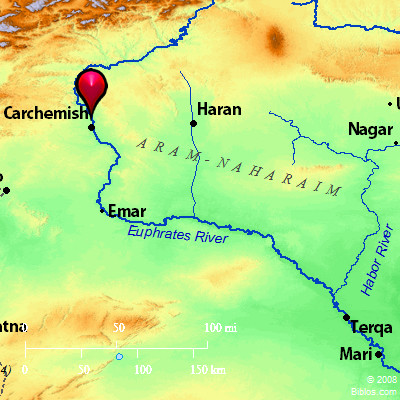Encyclopedia
CARCHEMISHkar'-ke-mish (karkemish; Charmeis, Karchameis): An exceedingly ancient Hittite city on the banks of the Euphrates, identified with Jerablus (Hierapolis) about 23 hours from Aleppo, between Birejik and Membij. The Assyrian form of the name is Kargamis or Gargamis, but its meaning is doubtful, the interpretation "Fort of the god Chemosh" having been suggested before it was known that the Assyrian-Babylon form of Chemosh was not Kamish or Gamish, but Kammusu (Kammosu). Systematic excavations on the site have apparently only just been made, those undertaken by Consul J. Henderson, after the death of G. Smith the Assyriologist, having been mainly devoted to the excavation of sculptures, etc. The site has vast walls and palace-mounds about. 8,000 ft. in circumference.
1. Evidence of the City's Early Existence:
The earliest occurrence of the name is in an adjectival form, namely, Karkarnisu, "Carchemishite," applied to a vase or measure of 200 qa, in a list of property at Sippar in the reign of Ammi-caduga (circa 1900 B.C.). Later on, the Egyptian poet known as Pentaur refers to the people of Carchemish (Qarqamesa) as forming, with the men of Arvad, Aleppo and Gozan, part of "the host of the miserable king of the Hittites" (Hattu-sil), who fought against Rameses II at the battle of Kadesh. The first Assyrian king to mention Carchemish is Tiglath-pileser I (circa 1268 B.C.), who states that he plundered "from the neighborhood of the land of Suhu (the Shuhites) as far as Carchemish of the land of Hattu" in one day.
2. Its Later History:
Later, the city attracted the attention of the Assyrian king Assur-nacir-apli, who started on the 8th of Iyyar, about the year 870 B.C., to the conquest of the district, and received tribute from the son of Bit-Bahiani; and, a little later, from Sangara of Carchemish, who is described as king of the Hittites. This tribute consisted of 20 talents of silver, various objects of gold, 100 talents of copper, 250 talents of iron, furniture, chariots and horses-an enormous treasure. Shalmaneser II, son of Assur-nacir-apli, also took tribute from the king of Carchemish here referred to. On the first occasion when the two monarchs met, Sangara was in alliance with the Sam'alians, Patinians, and Til-Bursip. After the capture of Sazabe (858 B.C.), a strong city of Sangara of Carchemish, all the opposing princes submitted. The tribute paid by the Hittite king on this occasion is depicted on strip F of the bronze coverings of the gates of Balawat, which has four representations of the place-two in the upper and two in the lower row of reliefs. The Kurkh monolith states that the tribute consisted of "2 talents of gold, 70 talents of silver, 80 talents of bronze, 100 talents of iron, 30 talents of purple stuff, 500 weapons, his daughter with a dowry, and 100 daughters of his great men, 500 oxen, and 5,000 sheep." A yearly tax was also imposed. The reliefs show two long trains of tribute-bearers, that in the lower row escorting the princess, who, apparently accompanied by her father, goes to meet the Assyrian king. Samsi-Adad, Shalmaneser II's son, merely mentions Carchemish as being on the western limits of his empire.
3. Tiglath-pileser IV Receives Its Tribute, and Sargon of Assyria Incorporates It:
In the time of Tiglath-pileser IV, the city was ruled by King Pisiri (s), who paid tribute as an Assyrian vassal. On the accession of Sargon of Assyria, however, Pisiris tried to throw off the Assyrian yoke, and made alliance with Meta of Moschi (Mesech) and other rulers, but was taken prisoner in the operations which followed. In the subsequent plundering of the city, those who suffered most were the inhabitants of the city who had been most active against Assyria. These were carried captive, and their places filled, as was the custom, by Assyrian settlers. The city's importance under Assyrian rule continued, the "mana of Carchemish" being one of the standard weights in use at Nineveh. After incorporation into the Assyrian empire it was ruled by Assyrian governors, one of whom, Bel-emuranni, was eponym for. the year 691 B.C. (reign of Sennacherib). The Old Testament gives later details. In the time of Josiah, Pharaoh Necoh marched to fight against the city, and the Jewish king went out to meet him, but lost his life at Megiddo (2 Chronicles 35:20). Four years later (605 B.C.), the Egyptian king was himself defeated by Nebuchadrezzar under the walls of the city (Jeremiah 46:2) in the battle which decided the fate of Western Asia.
4. Sculpture and Inscriptions Found at Carchemish:
The art of Carchemish was that of the Hittite nation to which the city belonged, but it was strongly influenced by the style of the Assyrians, and exhibits a mannerism if anything more pronounced. The Inscriptions found on the site are in the usual Hittite style-boldly carved natural objects and implements in relief arranged in boustrophedonbands between division-lines. It is not improbable, however, that cuneiform was also used, and texts in Phoenician characters may, by chance, be found. The patron-deity of the city was the Asiatic goddess Atargatis, whose worship, when the place lost its importance, was removed to the new Hierapolis now represented by the ruins of Membij.
T. G. Pinches
CARCHE'MISH, or Cbarchemish (meaning not known), a Hittite city of great importance, on the Euphrates river, discovered by consul Skene and George Smith, about 1876, at a place 16 ms. s. of the large Turkish town Bir on the w. side of the river. Prof. Sachau says that the true present name is Djerabis not Djerabolos. The ruins are remarkable and extensive and will soon be more thoroughly examined. See 2 Chron. 35:20. It was 380 ms. n. by e. from Jerusalem and about 350 ms. a little n, of w. from Nineveh. Its identification with Circesium, or Mabbogh-hierapolis,by Rawlinson and Maspero, is doubted.
Strong's Hebrew
H3751: Karkemisha city on the Euphrates




